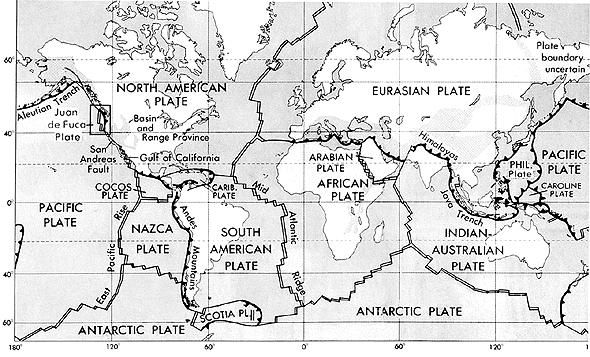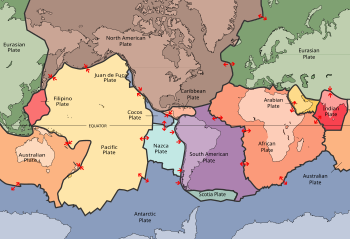Earth's lithosphere
In the Earth, the lithosphere includes the crust and the uppermost mantle which is joined to the crust across the mantle. The lithosphere is underlain by the asthenosphere, the weaker, hotter, and deeper part of the upper mantle. The boundary between the lithosphere and the underlying asthenosphere is defined by a difference in response to stress: the lithosphere remains rigid for long periods of geologic time, where as the asthenosphere flows much more readily. As the conductively cooling surface layer of the Earth's convection system, the lithosphere thickens over time. It is fragmented into tectonic plates (shown in the picture), which move independently relative to one another. This movement of lithospheric plates is described as plate tectonics. This is when plates move horizontally across the Earth's surface and the continents change their relative positions.
The concept of the lithosphere as Earth’s strong outer layer was developed by Barrell, who wrote a series of papers introducing the concept (Barrell 1914a-c). The concept was based on the presence of significant gravity anomalies over continental crust, from which he inferred that there must exist a strong upper layer (which he called the lithosphere) above a weaker layer which could flow (which he called the asthenosphere). These ideas were enlarged by Daly (1940), and have been broadly accepted by geologists and geophysicists. Although these ideas about lithosphere and asthenosphere were developed long before plate tectonic theory was articulated in the 1960s, the concepts that strong lithosphere exists and that this rests on weak asthenosphere are essential to that theory.
The division of Earth's outer layers into lithosphere and asthenosphere should not be confused with the chemical subdivision of the outer Earth into mantle, and crust. All crust is in the lithosphere, but lithosphere generally contains more mantle than crust.
There are two types of lithosphere:
- Oceanic lithosphere, which is associated with Oceanic crust
- Continental lithosphere, which is associated with Continental crust
[edit] Oceanic lithosphere
Oceanic lithosphere is typically about 50-100 km thick (but beneath the mid-ocean ridges is no thicker than the crust), while continental lithosphere has a range in thickness from about 40 km to perhaps 200 km; the upper ~30 to ~50 km of typical continental lithosphere is crust. The mantle part of the lithosphere consists largely of peridotite. The crust is distinguished from the upper mantle by the change in chemical composition that takes place at the Moho discontinuity.
Oceanic lithosphere consists mainly of mafic crust and ultramafic mantle (peridotite) and is denser than continental lithosphere, for which the mantle is associated with crust made of felsic rocks. Oceanic lithosphere thickens as it ages and moves away from the mid-ocean ridge. This thickening occurs by conductive cooling, which converts hot asthenosphere into lithospheric mantle, and causes the oceanic lithosphere to become increasingly dense with age. Oceanic lithosphere is less dense than asthenosphere for a few tens of millions of years, but after this becomes increasingly denser than asthenosphere. The gravitational instability of mature oceanic lithosphere has the effect that at subduction zones the oceanic lithosphere invariably sinks underneath the overriding lithosphere, which can be oceanic or continental. New oceanic lithosphere is constantly being produced at mid-ocean ridges and is recycled back to the mantle at subduction zones. As a result, oceanic lithosphere is much younger than continental lithosphere: the oldest oceanic lithosphere is about 170 million years old, while parts of the continental lithosphere are billions of years old. The oldest parts of continental lithosphere underlie cratons, and the mantle lithosphere there is thicker and less dense than typical; the relatively low density of such mantle "roots of cratons" helps to stabilize these regions (e.g., Jordan, 1978).
[edit] Mantle
Another distinguishing characteristic of the lithosphere is its flow properties. Under the influence of the low-intensity, long-term stresses that drive plate tectonic motions, the lithosphere responds essentially as a rigid shell and thus deforms primarily through brittle failure, whereas the asthenosphere (the layer of the mantle below the lithosphere) is heat-softened and accommodates strain through plastic deformation.
Geoscientists can directly study the nature of the subcontinental mantle by examining mantle xenoliths brought up in kimberlite and other volcanic pipes. The histories of these xenoliths have been investigated by many methods, including analyses of abundances of isotopes of osmium and rhenium. Such studies have confirmed that mantle lithospheres below some cratons have persisted for periods in excess of 3 billion years, despite the mantle flow that accompanies plate tectonics (e.g., Carlson et al., 2005).

